
MARS SOUTH POLAR
SPOUTS-PLANTS-FORESTS: Part 1
Report #101
April 23, 2006
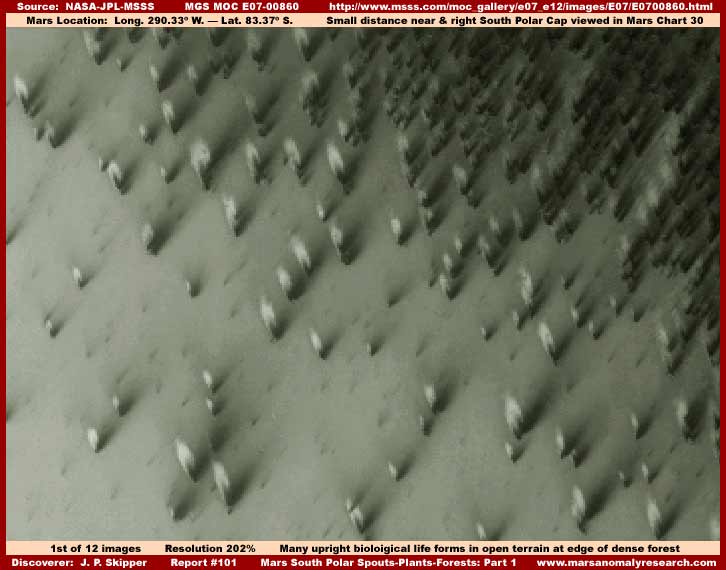
In Report #100, we took a little easier A-B comparison look at what some Mars forest life looks like from the point of view of conventional trees compared with known very similar forest evidence here on Earth and that these conventional forests do in fact exist on Mars with all their implications. Part of my reasoning for presenting samples of this previous easier to identify Earth similar Mars evidence first was to help you begin to understand that the true general Mars environment is much different than officially depicted and much more hospitable to life as we know it including forest life with known characteristics that we are familiar with.
However, that evidence when considered alone might lead one astray into thinking that Mars major forest life is all similar to that on Earth and that is just not the case. Now in this and the next few reports we're going to take a look at samples of biological forest life on Mars that is different than here on Earth and unique to Mars as a quite different world than Earth with its own independent course of evolution. I identify this evidence as "forest" life for the lack of a better term because this darker light absorbing evidence spreads, advances and carpets covering over and hiding wide area light reflective geological terrain surfaces just as forest do here on Earth.
Even so, while most of the evidence presented here in this first report may be a blend of similar to and different than Earth forest evidence, keep in mind that a lot of the more strange Mars South Polar Region evidence is most definitely not the individual tree forest life we are familiar with here on Earth. Rather it appears it may often be cooperative colony life that changes form and function through developmental metamorphosis stages from a below ground often fluid bound aquatic collective form that later ejects or erupts itself onto the Mars terrain surfaces where it develops into an above ground growing structure form sometimes looking very much like and sometimes probably functioning very much like vegetation but isn't really. Further, this unusual by our standards evidence is repeated over and over again in great variety suggesting a planetary stable eons long evolutionary branching cycle of development.
Meanwhile, the above first of seven images here in this report's Part 1 mostly drawn from the single very long MGS MOC E07-00860 official science data strip demonstrates forest life evidence they may be relatively similar to what we are familiar with here on Earth but also different in some ways to and especially in scale. The similarities make it easier for most viewers to recognize and digest and that's why this report will come before future following reports with more strange evidence.
The above first image is a scene of many well seen and well defined tightly compact upright but individual forms in open terrain each showing a uniformity of appearance from object to object, except for a variety of sizes. A first question that quickly comes to mind when viewing this evidence is whether these individual upright forms are geological spouts or geysers or do they represent something else entirely such as the evidence in my previous 5/21/05 Report #087. The key to understanding this is the immediately adjacent proximity of a huge darker light absorbing very dense forest mass and the accumulation of similar evidence in other strips you will see here where these upright forms are always in close proximity to the dark light absorbing forest mass evidence.
As will become increasingly clear in this report as the visual evidence accumulates, these spout looking objects are the beginnings of a forest evidence forming out in open geological terrain just out from a main forest body. Now it could be that the above 1st image individual upright forms may be collective colony life ejecting out of the ground in a spout or plume similar to my Report #087. The lack of darker material accumulating at their base ejection point or in an adjacent ground plume stain may merely mean that these objects have been at this developmental stage for a while and such evidence has been absorbed back into the ground. On the other hand, this could just simply be plant life not connected to colony organisms to.
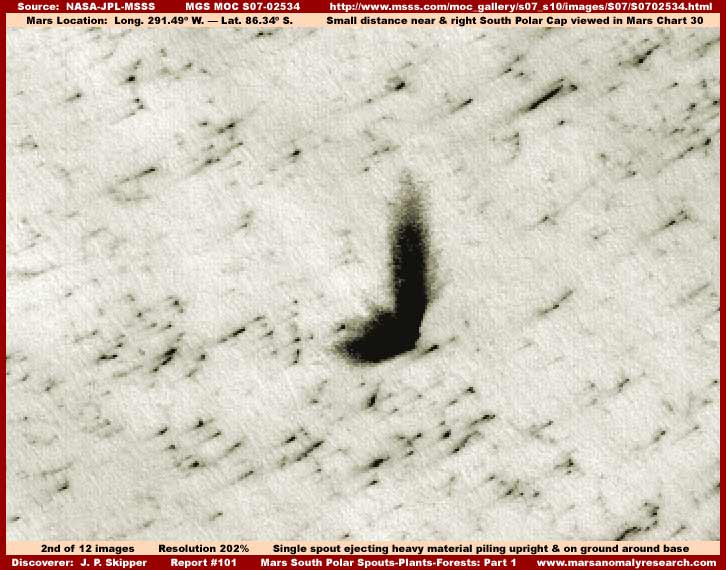
The above second image evidence from different strip S07-02534 demonstrates a single large spout in action having ejected heavier bodied material into the air and onto the ground very close to its base. It demonstrates an example of what these colony life spouts look like in comparison to the evidence in the above first image. This particular ejection is a large and a lone one in the terrain. Note that it has almost no long plume stain on the ground extending out from its base ejection point indicating this colony fired perhaps prematurely without the presence of strong wind currents to spread the ejection material into a bigger get started footprint.
So it may be that the upright objects in the above first image are individual plants getting started in this open terrain just out from the great forest main body and are therefore vegetation in the sense we are familiar with. Note how they originate from a single point in the ground at their base and widen out into a light color fan shape going upward. Note the lack of a dark area of material building up on the ground at the base of the upright form in the first image evidence as compared to the second image evidence. The one thing that we can safely observe is that these upright forms are not some form of inanimate geological or chemical activity geysers or spouts. Their close proximity to the densely packed forest evidence in the upper right corner of the first image is a strong clue and typical of this type of evidence as will become increasingly clear in this report as more such evidence accumulates.
The great advantage to us here in the above first image is that this is a clear slightly oblique or angled view providing a excellent look at not only the vertical biological life objects but also the shadow that they cast to their right and behind them in direct proportion to their vertical size as well as their base area. We are also lucky that this evidence exists near the middle of this very long science data strip where the resolution is at its best when not otherwise compromised so much by image tampering. In such a long strip, as one moves toward either end, the resolution degrades.
This is a very rare relatively uncompromised view of this type of evidence at work in the Mars terrain and perhaps the best you will see here in this report providing solid information. Most of this type of evidence is significantly obscured by imaging problems both legitimate and otherwise but also by a normally much more straight down view lacking such oblique angle detail of upright forms. This type of upright form life evidence is very plentiful and in great variety in the Mars South Polar Region but is most often visually difficult to recognize because of the poor resolution imaging, obscuring image tampering, and straight down view as well as the evidence's variety and slightly different visual looks.
Key to this evidence's recognition and its relationship with other evidence is in the upper right corner of my above image where there is the beginning of a large patch of forest evidence. You will see more bulk of this forest evidence in the next image below. The reason that I've included the edge of this forest patch in this first image is to demonstrate that this upright individually seen evidence is forest life at work in this scene as the edges of the forest main body spreads out into the more open terrain at its edges via these individual upright forms spreading and establishing the beginnings of a foot hold there. In other words, this upright life evidence in this more open terrain represents the advancement and spread of forest life that eventually fills in the gaps and establishes itself as densely packed vegetation forest evidence carpet and hiding the underlying terrain from view as seen in mass in the next image below.
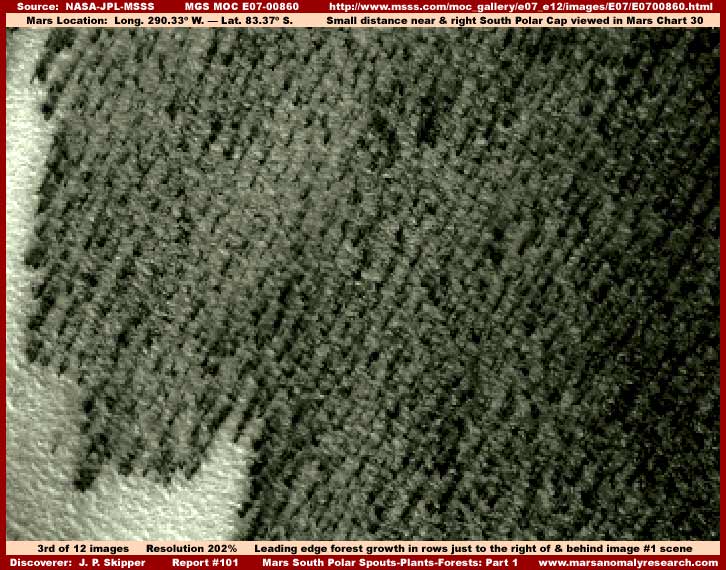
The above third image scene from the same E07-00860 strip looks very much like densely packed forest vegetation evidence and that's because that is what it is. It is a scene just below and to the right of the first image scene. I've included just a little bit of the more light reflective open terrain geology on the left edge of the image to provide identifying contrast for the darker more light absorbing densely packed and carpeting living growth in the rest of the image to the right of the open terrain and to make sure that you recognize the difference between what the more solar light reflective geological terrain looks like versus the darker light absorbing living forest evidence.
The living growth area is actually quite a bit darker in the science data image than seen here but I've lightened it here to provide a look at the detail of the vegetation texture patterns. Note how the darker living mass tends to orient into many parallel row rope looking patterns, all oriented in the same direction. In that regard the forest upper surface texture patterns are different than the conventional tree forest patterns demonstrated in my previous Report #100. This appears to be a unique characteristic of this particular vegetation species type.
Please also note in the open terrain at the edge of the forest on the left that there is clearly no geological land undulations or parallel folds that might encourage this type of row orientation growth. Therefore, I think we can safely assume that this visual row orientation is a function of the living specie type and not a function of the underlying inanimate geology. We can't know for sure here without better visual evidence but it is possible and often a characteristic some types of this colony life that it sometimes physically alters and changes the terrain upon which it exists.

This E07-00860 science data strip is a very long slice across a wide area forest where multiple different specie types compete. In this overall forest, the growth appears in specie type groups covering large areas and do not visually seem to readily mix with each other. The above fourth image from this same strip is a scene below that in the third image and demonstrates the densely packed row vegetation evidence seen in the third image here in this image on the left encountering and merging with possibly a different specie type on the right. At least the texture patterns and row orientations are visually different.
Of course the difference could be explained by other factors influencing the same specie type evidence but causing it to appear different. For example, the evidence on the right could be an older patch and flagging in health causing it to look different or a more mature slightly different looking form. Possibly but I doubt it. I suspect that the answer to these visual differences lies in different specie types carving out space for themselves in large patches within the overall forest, all capitalizing on the same favorable conditions in this locale that encourages successful growth.
But, if you don't get but one thing out of this image evidence, at the very least get the fact that no light reflective terrain geology evidence is visible here in this third image scene at all. It is hidden beneath the carpeting living forest evidence that is covering it confirming that it is dynamic carpeting living forest life evidence generally behaving just as old growth forests do here on Earth.
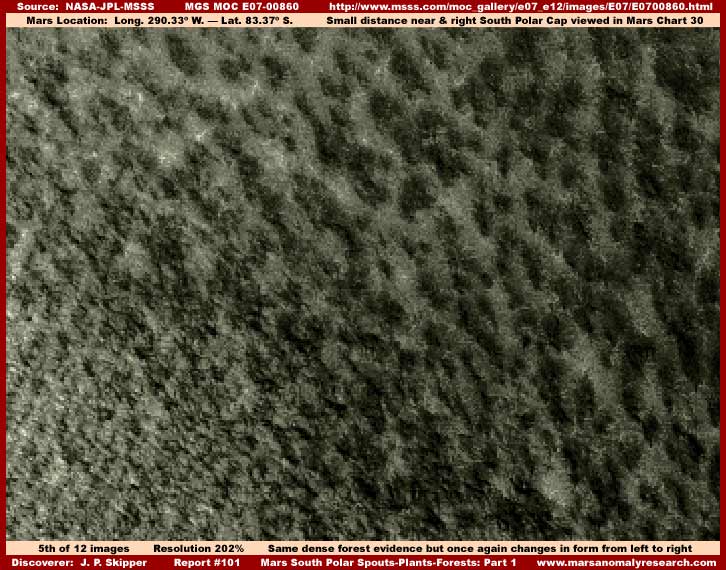
The above fifth image from the same E07-00860 strip is a scene very similar to the fourth image. This is the same overall forest but again a scene further down below the others and further down the image strip. Here again you have a little of one kind of vegetation evidence in the lower left corner (row type) and the rest to the right of that is quite different. Again note that the visually different looking growths do not seem to readily mix and, if true, this is evolution contrary to Earth mixed tree forests behavior.
Note again that nothing of the more light reflective terrain geology is visible at all, only this darker light absorbing vegetation life carpeting everything. Very important, look very closely and note that the spaces between the darkest plants on the right are actually not light reflective geological terrain spaces but are filled with and covered over by lighter color finer texture life looking very much like dense tangles of vines, roots, or limbs. It is the same in the 4th image evidence on the right but less well seen.
I suspect that this does not represent dying and deteriorating life but looks something like the poorly seen piled evidence in Report #100, Part 3, Image #10. If so, it is indeed very strange life evidence relative to what we are familiar with.
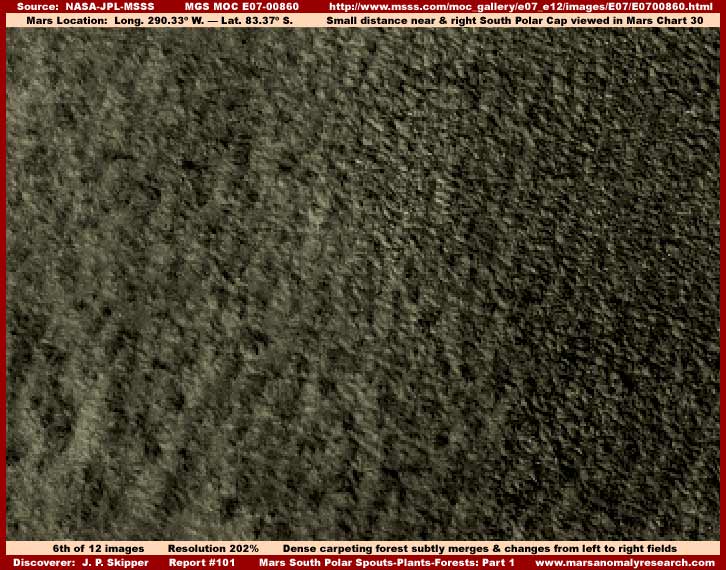
The above sixth image demonstrates again a change in the texture patterns of the vegetation forest moving from the left field of this image to the right. The transition boundary is a little less pronounced and more subtle here because there is a bit more gradual merging of the two specie types. The evidence on the left is a little broader, smoother and more coarse textured whereas the evidence in the right field is smaller, tighter more knobby patterned. Although not imaged here, the tighter more knobby patterned specie type on the right gets much more pronounced and sharper detailed moving further down the strip.
Again it is the same overall forest and with large areas of this visually different looking specie type vegetation and/or colony life evidence on much larger scales than what I've sampled here. Again you can see that this living forest engulfs and carpets everything completely hiding any natural more light reflective solid particulate geological terrain from view. It is what old growth forests do in favorable conditions and when left alone without external intervention. One thing is absolutely sure, this kind of living, spreading, growing evidence cannot even remotely be confused with natural geological terrain and is incredibly strange that even scientists independent of NASA, JPL, etc. cannot seem to grasp this very obvious fact.
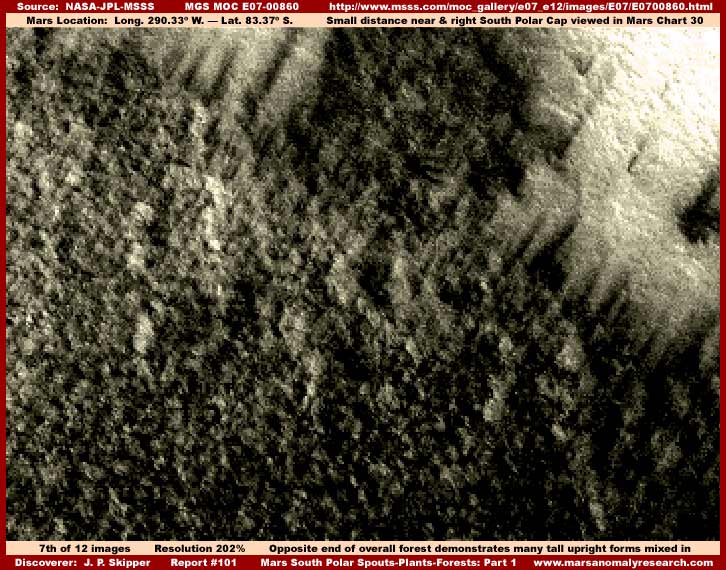
The above seventh image is at the very bottom of the strip while the first image at the beginning of this report is located roughly near the middle of the very long strip. We've been moving down the strip with this evidence sampling sections along the way. Actually, I rotated the strip 90º counterclockwise to provide the views seen here but that had no impact on the evidence other than giving a more comfortable view of it. The top part of the strip is mostly open terrain and I might add again that the resolution quality deteriorates moving down the strip from the midpoint to the bottom and is at its worst here in this sixth image.
The reason that I'm including this poorer quality blurry sixth image is because you can still relatively easily recognize some tall upright growth forms contrasting against the more light reflective terrain at the edge of the more dense forest growth. Once recognized and understood, it is then an easier matter to move your eye back into the confusion of the darker more dense growth area and continue to see and pick out some of those same upright forms there. The bottom line is that this massed upright forest evidence is still recognizable as the life evidence it is and not to be confused with any kind of natural geology as represented by the more light reflective solid particulate geological terrain in the upper parts of the above 7th image forming the visual background.
As you can also see, the upright form evidence does not appear to look that much like it does in the first images. This can be explained because the massed forest evidence in each image also doesn't look the same. No doubt the tight super dense parallel row pattern forest evidence in the first and second images is a specie type that produces the well seen unique looking tapered fan shaped young upright forms in the first image while the more poorly seen darker upright forms in the seventh image are a different specie.
So far in this report's Part 1 we've examined forest life evidence mostly from just the single E07-00860 strip. It was worth it to take a look at the excellent view of the upright form evidence in the first image and also the lesser quality views of different vegetation forest evidence stretching out near it that is like but also in some ways not like Earth evidence. This evidence demonstrates just how very much alive Mars is and how completely contrary that is to the official information disseminated to us.
Now let's move on to the final Part 2. There we will see more Mars South Polar upright form evidence and in relation to massed forest evidence from different strips reinforcing the recognition that this evidence is indeed living forests at work on Mars and not to be confused with inanimate natural solid particulate geology.
DOCUMENTATION
http://www.msss.com/moc_gallery/e07_e12/images/E07/E0700860.html: This link takes you to the official MGS MOC E07-00860 narrow-angle science data strip from which my above 1st and 3rd–6th images were sourced. It is a very long strip with the top part of it being mostly light color solar light reflective open geological terrain and the rest below that is dark light absorbing forest evidence. The forest evidence in this report's first image begins where the the light reflective terrain starts turning dark in the strip.
http://www.msss.com/moc_gallery/s05_s10/images/S07/S0702534.html: This link takes you to the official MGS MOC S07-02534 narrow-angle science data strip from which my above second image was sourced demonstrating the single spout or geyser.
![]()